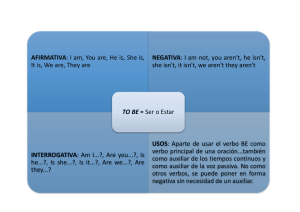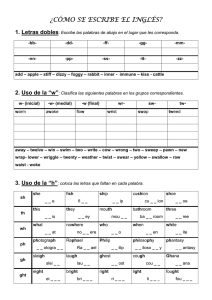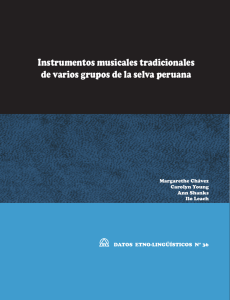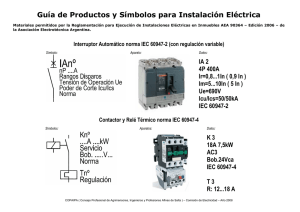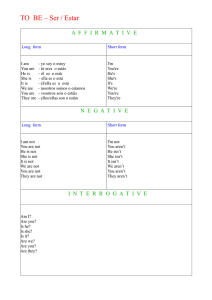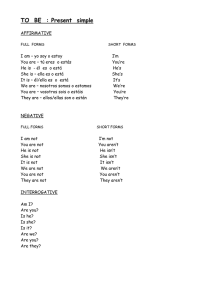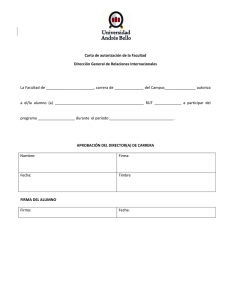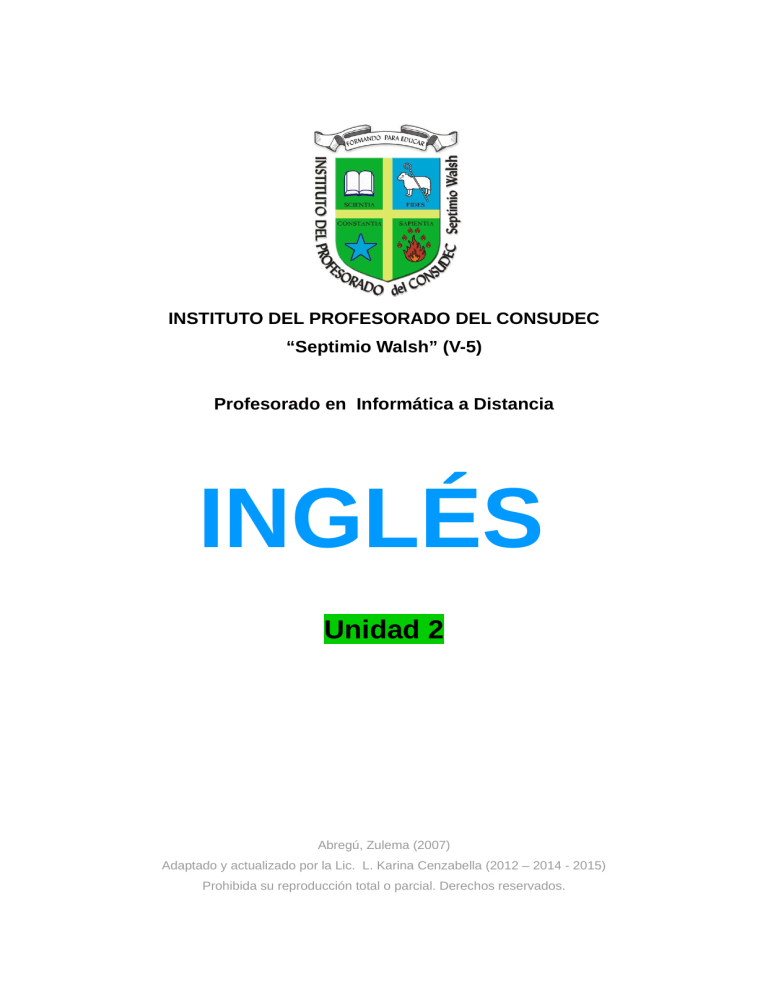
INSTITUTO DEL PROFESORADO DEL CONSUDEC “Septimio Walsh” (V-5) Profesorado en Informática a Distancia INGLÉS Unidad 2 Abregú, Zulema (2007) Adaptado y actualizado por la Lic. L. Karina Cenzabella (2012 – 2014 - 2015) Prohibida su reproducción total o parcial. Derechos reservados. ANTES DE COMENZAR: Considerando que en la actualidad la mayor parte del conocimiento técnico y científico está expresado en idioma inglés, poder leer comprensivamente es un requerimiento para usted como estudiante del profesorado en Informática, a la vez que puede resultar un desafío, al no ser su lengua nativa. Los textos de contenido tecnológico-informático pueden contener una gran cantidad de información, la mayoría de la cual se refiere a hechos. Como lectores de dichos textos debemos ser capaces de extraer información, pero también de comprender la totalidad del material, lo que requiere una lectura detallada. La finalidad de este curso que usted está por comenzar es brindarle herramientas que le permitan: interpretar el significado de las palabras, entender oraciones y comprender párrafos. En resumen, que usted aprenda a leer inglés técnico entendiéndolo. Para lograr este objetivo, lo guiaremos a través de un estudio comparativo de la gramática del inglés y del español, y el correcto uso del diccionario bilingüe. El siguiente material de estudio ha sido organizado en un orden de complejidad creciente con el propósito de que usted encuentre la menor cantidad de dificultades para el logro de los objetivos. 2 Instituto Consudec Campus: http://iec.campusterciario.com.ar/ CONSEJOS PARA TENER EN CUENTA: Cuando usted realiza una traducción lo que transfiere de un idioma a otro son ideas y no solamente palabras. Debe ser fiel al original, dejando de lado lo superfluo, lo que no agrega nada al texto, y conservando lo sustancial, pero evitando la repetición. Use el diccionario: no se deje llevar por la similitud de las palabras; busque las palabras que no conoce o sobre las que tiene dudas . Antes de contestar las preguntas de la lecto-comprensión o de realizar una traducción, lea todo el texto, aún cuando haya palabras que desconozca. Al finalizar cada bloque gramatical encontrará una serie de actividades para que usted pueda practicar comprensión y traducción mediante la aplicación de las técnicas y las estructuras aprendidas. También encontrará la resolución de las mismos. Es aconsejable no consultar la resolución hasta que haya agotado todos los medios para la realización de los ejercicios por su cuenta. Recuerde que no existe una sola forma de redactar la traducción o las respuestas de la comprensión ya que, como aclaramos, trabajamos con ideas y no con palabras aisladas. Ahora sí, continuamos… Let’s go on…. 3 Instituto Consudec Campus: http://iec.campusterciario.com.ar/ UNIDAD 2: Bloque verbal EL VERBO Clasificación de los verbos • De acuerdo con su contenido: 1. Verbos que indican actividad to walk: caminar to eat: comer 2. Verbos que indican condición to sleep: dormir to live: vivir 3. Verbos que indican cambio to turn: volver / convertirse to finish: acabar / terminar Según su empleo algunos verbos pueden pertenecer a más de una categoría. Ej.: They live in Paris. Viven en París. (indica condición) I want to live. Quiero vivir. (indica actividad) De acuerdo con su función: 4 Instituto Consudec Campus: http://iec.campusterciario.com.ar/ 1. Verbos principales: son aquellos que contienen todo el significado del predicado. She gave him a present. Le hizo un regalo. He can read. Sabe leer. 2. Verbos auxiliares: son aquellos que se emplean para la formación de los tiempos, modo, aspecto, voz y predicación. The boy did´nt tell the truth. El chico no dijo la verdad. They are leaving tomorrow. Se marchan mañana She has updated the antivirus. Ella ha actualizado el antivirus. 3. Verbos modales: Tienen significado propio; comparten características de los verbos auxiliares. She can swim very well. Sabe nadar muy bien May I open the window, please? ¿Puedo abrir la ventana, por favor? De acuerdo con la forma: Los verbos ingleses basan su conjugación en tres formas únicamente que representan el enunciado de un verbo. Son: infinitivo (to know), pretérito o pasado (knew) y participio pasado (known). Atendiendo a estos tres elementos básicos, los verbos se clasifican en: Regulares: Toman la terminación -ed de inflexión, añadida a la raíz o infinitivo para formar el pretérito y el participio pasado. To play played played (jugar, interpretar) 5 Instituto Consudec Campus: http://iec.campusterciario.com.ar/ To study studied studied (estudiar) Irregulares: Son verbos que tienen las tres formas iguales, dos formas iguales y una desigual, las tres formas desiguales. To cut To keep To drink To show cut kept drank showed cut kept drunk shown (cortar) (guardar, conservar) (beber) (mostrar, enseñar) De acuerdo con su formación: Simples: Son aquellos que están formados por una sola palabra. To think To work pensar trabajar Compuestos: Están formados por más de una palabra. To outdo To overcome aventajar vencer Dentro de este grupo se encuentran también los verbos fraseológicos (phrasal verbs) y los preposicionales (prepositional verbs). To look at To come in mirar a / hacia entrar (prepositional) (phrasal) 6 Instituto Consudec Campus: http://iec.campusterciario.com.ar/ Infinitivo go (ir) “s” goes (va) “-ing” going (yendo) pasado went (fue) participio pasado gone (ido) work (trabajar) works (trabaja) working (trabajando) worked (trabajó) worked (trabajado) Estas formas se combinan con los auxiliares y van a determinar los distintos tiempos verbales. Los fundamentales son cuatro: presente pasado futuro condicional o potencial Y cuatro son las formas en que estos tiempos se combinan, a saber: simple continuada perfectiva perfectiva continuada Los verbos auxiliares que empleamos en su formación son: 7 Instituto Consudec Campus: http://iec.campusterciario.com.ar/ To be (ser o estar) To have (haber) Do/did/does Para formar el Will Para formar los Para formar los negativo e Para el tiempo tiempos continuos. tiempos perfectivos. interrogativo del futuro simple. presente y pasado simple. Verbo To Be Presente Pasado Futuro simple I am You are He is She is It is We are You are They are simple I was You were He was She was It was We were You were They were simple I will be You will be He will be She will be It will be We will be You will be They will be Verbo To Have (haber - como auxiliar) Presente simple Pasado Futuro simple I have You have He has She has It has We have You have They have I had You had He had She had It had We had You had They had simple I will have You will have He will have She will have It will have We will have You will have They will have Instituto Consudec Campus: http://iec.campusterciario.com.ar/ 8 Do - Does - Did (auxiliares para formar el negativo e interrogativo del Presente y Pasado Simples) Presente Simple Pasado Simple I do (not) I did (not) You do (not) You did (not) He does (not) He did (not) She does (not) She did (not) It does (not) It did (not) We do (not) We did (not) You do (not) You did (not) They do (not) They did (not) TIEMPOS VERBALES Tiempos Simples Presente Simple: Este tiempo se utiliza para describir una acción habitual. Todas las personas tienen la misma forma con excepción de las tercera persona del singular a la que se le agrega una “s” ó “es” de acuerdo a la terminación del verbo. I You He She It We You They sleep sleep sleeps sleeps sleeps sleep sleep sleep (yo) duermo (usted) duerme (él ) duerme (ella) duerme (el –gato-) duerme (nosotros/as) dormimos (ustedes) duermen (ellos/as) duermen 9 Instituto Consudec Campus: http://iec.campusterciario.com.ar/ Para preguntar se usa el auxiliar DO para todas las personas, salvo en las terceras personas del singular que llevan el auxiliar DOES Forma Afirmativa I work Forma Negativa I do not work Forma Interrogativa Do I work? (¿trabajo?) (trabajo) You work He works She works It works We work You work They work (no trabajo) do not work does not work does not work does not work do not work do not work do not work Do you work? Does he work? Does she work? Does it work? Do we work? Do you work? Do they work? En conversaciones es muy común contraer “do not” y “does not” por “don’t” y “doesn’t”, respectivamente. Pasado Simple: Este tiempo verbal describe una acción pasada. En el pasado simple se usa el mismo verbo auxiliar para todas las personas. La forma negativa e interrogativa se forma con el auxiliar did + la forma base del verbo. 10 Instituto Consudec Campus: http://iec.campusterciario.com.ar/ Ej. : I did not (= didn’t) listen to her. (No la escuché.) He did not study for the exam. (No estudió para el examen.) Did you understand the problem? (¿Entendió el problema?) Where did they go yesterday? (¿Adónde fueron ayer?) …………………………………………......... Consultar lista de verbos irregulares (página 29) * …………………………............ Futuro Simple: Se forma con el auxiliar “will” seguido de la forma base del verbo principal; es igual para todas las personas. Ej. I will get the scholarship. (Obtendré la beca.) You will work in this office. ( Trabajará/s en esta oficina.) We will study it very carefully. (Lo estudiaremos cuidadosamente.) She will type the report. (Escribirá el informe a máquina/en computadora.) Para formar el interrogativo, invertimos el orden del auxiliar y verbo principal: 11 Instituto Consudec Campus: http://iec.campusterciario.com.ar/ Will you finish the report soon? (¿Terminará el informe pronto?) Will they arrive on time? (¿Llegarán a tiempo?) Para formar el negativo se agrega "not "al auxiliar: I will not see you. (No lo veré.) We will not be here tomorrow. (No estaremos aquí mañana.) Tiempos Continuos Todos los tiempos continuos se forman con el verbo "TO BE" y la forma "ing" del verbo principal. Presente Continuo I am writing. (Estoy escribiendo.) They are studying. (Están estudiando.) Is she working in the new department? (¿Está trabajando en la nueva sección?) He is not studying there. (No está estudiando allí.) Pasado Continuo She was studying for the exam. (Estaba estudiando para el examen.) They were repairing the computer. (Estaban arreglando la computadora.) 12 Instituto Consudec Campus: http://iec.campusterciario.com.ar/ Were they working? (¿Estaban trabajando?) He was not repairing the system. (No estaba arreglando el sistema.) Tiempos Perfectivos Se forman con el auxiliar "TO HAVE" y el participio pasado del verbo principal. Presente Perfecto have / has + participio pasado del verbo principal. En el caso de los verbos regulares, el participio pasado es igual al pasado simple, es decir, se agrega "-ed" o "-d". En el caso de los verbos irregulares, es la tercera columna. Ej. She has typed the report. (Ha escrito el informe a máquina/en computadora.) They have changed the computers. (Han cambiado las computadoras.) I have been here before. (He estado aquí antes.) La negación se forma agregando "NOT" después de HAVE / HAS, y la interrogación invirtiendo el orden del auxiliar y el sujeto. I have not telephoned her. (No la llamé por teléfono/ No la he llamado por teléfono.) 13 Instituto Consudec Campus: http://iec.campusterciario.com.ar/ She has not arrived yet. ( Todavía no llegó/ No ha llegado todavía.) Have you seen her today? (¿Hoy la vio?/ ¿La ha visto hoy?.) Has he studied for the test? (¿Estudió para la prueba?/¿Ha estudiado para la prueba?) Pasado Perfecto "had" + el participio pasado del verbo principal. El negativo se forma agregando "NOT" después de "HAD", y el interrogativo invirtiendo el orden del auxiliar y el sujeto. When I arrived, the manager had left (Cuando llegué, el gerente se había ido) When she left, I had eaten my sandwich. (Cuando se fue, me había comido mi sandwich.) When he arrived, they had not finished the report. (Cuando llegó, no habían terminado el informe.) Had they remembered the meeting when he telephoned?. (¿Se habían acordado de la reunión cuando él llamó?) LOS VERBOIDES FORMA "-ing" 14 Instituto Consudec Campus: http://iec.campusterciario.com.ar/ PREPOSICION + -ING se traduce PREPOSICION + INFINITIVO It is a device for controlling the cursor. Es un dispositivo para controlar el cursor. The flowchart shows the path the computer will follow in executing the program. El diagrama de flujo muestra la ruta que seguirá la computadora al ejecutar el programa. BY + ING cuando indique la manera de realizar algo. With this program you can select hundreds of pictures simply by moving the mouse. Con este programa puede seleccionar cientos de dibujos simplemente moviendo el mouse. No traducimos la preposición; el verbo se traduce con la terminación "ando", "endo". Al comienzo de la oración se traduce como sustantivo o infinitivo Programming is very interesting. La programación es muy interesante. Programar es muy interesante. 15 Instituto Consudec Campus: http://iec.campusterciario.com.ar/ SUSTANTIVO+ ING se traduce SUSTANTIVO + QUE + VERBO Programs are instructions telling the computer what operations have to be carried out. Los programas son instrucciones que le indican a la computadora que operaciones se deben realizar. AFTER / BEFORE + ING se traduce DESPUES / ANTES DE + INFINITIVO I often listen to music after working. A menudo escucho música después de trabajar. INFINITIVO puede traducirse: A + INFINITIVO I stopped for a few minutes to rest. Me detuve un momento a descansar. PARA + INFINITVO She went to England to know more about British culture. Fue a Inglaterra para conocer más sobre la cultura británica. 16 Instituto Consudec Campus: http://iec.campusterciario.com.ar/ DE + INFINITIVO He tried to forget the incident. Trató de olvidar el incidente. QUE + VERBO CONJUGADO They don't permit people to smoke. No permiten que la gente fume. The rate of inflation is expected to rise. Se espera que aumente el índice de inflación. MODO IMPERATIVO Afirmativo: Se forma con el infinitivo sin "to" colocado al comienzo de la oración y sin el pronombre personal. Unplug electrical appliances before repairing them. Desenchufe los artefactos eléctricos antes de arreglarlos. Negativo: Se comienza la oración con do not / don't seguido por el infinitivo sin "to". Do not ( don't )press the return key. No presione la tecla "return". Imperativo con "LET": Se forma con "let's" (let us) seguido del infinitivo sin "to". 17 Instituto Consudec Campus: http://iec.campusterciario.com.ar/ Let's follow the instructions. Sigamos las instrucciones. Let's read the summary. Leamos el resumen. VOZ PASIVA EL SUJETO DE LA VOZ PASIVA ES EL OBJETO DE LA VOZ ACTIVA V. Pasiva: This house was built in 1486. sujeto Esta casa se construyó en 1486. V. Activa: They built this house in 1486. objeto Construyeron esta casa en 1486. La voz pasiva se utiliza cuando nos interesa enfatizar quién o qué recibe la acción del verbo, en lugar de quién o qué realiza la acción. La estructura de la voz pasiva es: VERBO "TO BE" + PARTICIPIO PASADO TIEMPO DE LA VOZ ESTRUCTURA EJEMPLO PASIVA Presente Simple am/is/are + participio pasado English is spoken here. Presente Continuo am/is/are being + pp The house is being painted. Pasado Simple was/were + pp I wasn't invited, but I went. Pasado Continuo was/were being + pp I felt I was being watched. 18 Instituto Consudec Campus: http://iec.campusterciario.com.ar/ Presente Perfecto have/has been +pp Has Mary been told? Pasado Perfecto had been + pp I knew I had been forgotten. Futuro Simple will be + pp You will be told soon. Verbos modales can/could/must/should (página 18) be + pp The car should be repaired. Cuando en la oración pasiva no aparece "by", la traducción es impersonal: SE + VERBO CONJUGADO The plan is called a flow chart. El plan se llama diagrama de flujo. Hundreds of megabytes of software can be recorded on one disk. Cientos de megabytes de software se pueden grabar en un disco. Cuando en la oración pasiva aparece "by", la traducción es literal: The telephone was invented by Graham Bell. El teléfono fue inventado por Graham Bell. Manchester were beaten 3-0 by Liverpool yesterday. Ayer Manchester fue derrotado 3-0 por Liverpool. Cuando la voz pasiva va seguida de un infinitivo, se traduce: VOZ PASIVA IMPERSONAL (SE) + QUE + VERBO CONJUGADO You are supposed to know the answer. Se supone que conoces la respuesta. 19 Instituto Consudec Campus: http://iec.campusterciario.com.ar/ Esta traducción sólo se realiza con verbos tales como: say, suppose, think, assume, consider, believe, etc. Cuando se utilizan otros verbos la traducción se efectúa de la siguiente manera: It is used to store information. Se utiliza para almacenar información. USOS ESPECIALES DE "BE", "HAVE", "DO" BE * Cuando deseamos enfatizar ideas presentes con intención, seguridad o planes de que se cumplan en el futuro, utilizamos la construcción: BE + GOING TO + VERB Next year is going to be different. El año próximo va a ser diferente. It is going to rain: look at those clouds. Va a llover: mire esas nubes. They were going to buy a ink-jet printer but finally they bought a laser one. Iban a comprar una impresora a chorro de tinta pero finalmente compraron una láser. * Como equivalente de "must" en la construcción: 20 Instituto Consudec Campus: http://iec.campusterciario.com.ar/ BE TO + VERBO You are to stop smoking or you will die. Debes dejar de fumar o te morirás. * También puede traducirse "ir a" según el contexto en que se emplee. She is to come tomorrow. Va a venir mañana. * Se traduce "es probable que" en la siguiente construcción: BE LIKELY + VERBO It is likely to rain. Es probable que llueva. The virus is likely to damage data on the disk. Es probable que el virus dañe los datos del disco. * Se traduce "haber " o "existir" en la construcción: THERE + BE There is no water on the moon. No hay agua en la luna. There were many children sleeping in the street. Había muchos niños durmiendo en la calle. 21 Instituto Consudec Campus: http://iec.campusterciario.com.ar/ * Se traduce "tener" en casos como: She is fifteen years old. Tiene quince años. It is 50 cm wide. Tiene 50 cm de ancho. HAVE * En la construcción: HAVE + OBJETO + PARTICIPIO PASADO I had my watch repaired. Hice arreglar mi reloj. They will have their house decorated next week. Harán decorar su casa la próxima semana. * Se traduce como equivalente de "must" (obligación) en la estructura: HAVE TO + VERBO You have to pay in advance. Debe pagar por adelantado. They have to go to London for a meeting. Deben ir a una reunión en Londres. 22 Instituto Consudec Campus: http://iec.campusterciario.com.ar/ La diferencia entre el uso de "must" y "have to" reside en que en el caso de "must" la obligación es sentida por el sujeto, mientras que en la expresión "have to" la obligación viene desde afuera. I must stop smoking. Debo dejar de fumar. (es mi deseo) I have to stop smoking. Debo dejar de fumar. (por indicación del médico) DO * Se utiliza para enfatizar el verbo y se traduce "ciertamente", "realmente", en la estructura: DO + VERBO I said I was going to win, and I did win. Dije que iba a ganar y ciertamente gané. I do feel ill! Realmente me siento enferma. 23 Instituto Consudec Campus: http://iec.campusterciario.com.ar/ VERBOS ESPECIALES (MODAL VERBS) SHOULD * Se traduce: deber, debería, debiera People should drive more carefully. La gente debería manejar con más cuidado. OUGHT TO + VERBO * Puede utilizarse con un significado similar a "should": We ought to discuss the problem. Debemos discutir el problema. MUST * Se utiliza para órdenes, consejos u opiniones y se traduce "deber": Passengers must not speak to the driver. Los pasajeros no deben hablar con el conductor. He must realise that he is in trouble. Debe darse cuenta de que está en problemas. CAN * Se traduce "poder" y se puede utilizar con el sentido de: a) habilidad b) permiso, requerimientos, ofrecimientos: 24 Instituto Consudec Campus: http://iec.campusterciario.com.ar/ She can speak English quite well. Puede hablar inglés bastante bien.(habilidad) You can't come into my room. No puedes entrar en mi cuarto.(permiso) Can you put the children to bed? ¿Puede acostar a los niños?(requerimiento) MAY * Se utiliza con el sentido b) de "can", pero es más formal y menos frecuente: May I help you, sir? ¿Puedo ayudarlo, señor? May I use your phone? ¿Puedo usar su teléfono? COULD * Se utiliza con el mismo sentido que "can" y se traduce "podría": Could I pay you tomorrow? ¿Podría pagarle mañana? MIGHT * Se utiliza para indicar una posibilidad más remota que usando "may" y 25 Instituto Consudec Campus: http://iec.campusterciario.com.ar/ también se traduce "podría": My mother might be at home now. Mi madre podría estar en casa ahora. FALSOS GOGNADOS Son palabras que tienen la misma forma en inglés y español pero distinto significado. Ability: capacidad, destreza, aptitud Actual: verdadero, real Actually: en realidad Assume: suponer College: facultad Billion: mil millones Compass: brújula Consistent: constante, consecuente Eventually: finalmente Exit: salida File: archivo, fichero Implications: consecuencias, efectos, repercusiones Lecture: conferencia Library: biblioteca Notice: aviso Regular: habitual, normal Simple: sencillo, ordinario 26 Instituto Consudec Campus: http://iec.campusterciario.com.ar/ Por supuesto que esta lista es bastante más amplia y estos "falsos amigos" pueden llevarnos a cometer graves errores no sólo de traducción sino de comprensión. Recordemos en estos casos que "las apariencias engañan". EVALUACIÓN 1 Realice la actividad de integración 5 Preguntas Orientadoras para la Unidad 2, disponible como archivo Word en el campus virtual, y envíela a su tutora. Vocabulario específico del área informática En los siguientes artículos encontrarán los verbos, adjetivos y adverbios más utilizados en los textos técnicos resaltados en color azul. Algunos de ellos son palabras transparentes, es decir, se ven igual o casi igual a su traducción en castellano. Use estos párrafos para crear su propia lista de verbos de referencia, para poder consultar en el futuro a modo de mini-diccionario. Software Maintenance In software engineering, software maintenance is the process of enhancing and optimizing deployed software (software release), as well as remedying defects. Software maintenance is one of the phases in the software development process, and follows deployment of the software into the field. The software 27 Instituto Consudec Campus: http://iec.campusterciario.com.ar/ maintenance phase involves changes to the software in order to correct defects and deficiencies found during field usage as well as the addition of new functionality to improve the software's usability and applicability. Software maintenance involves a number of specific techniques. One technique is static slicing, which is used to identify all the program codes that can modify some variable. It is generally useful in refactoring program codes and was specifically useful in assuring Y2K compliance. The software maintenance phase is an explicit part of the waterfall model of the software development process which was developed during the structured programming movement of computer programming. The other major model, the spiral model developed during the object oriented movement of software engineering, makes no explicit mention of a maintenance phase. Nevertheless, this activity is notable, considering the fact that two-thirds of a software system's lifetime cost involves maintenance. In a formal software development environment, the developing organization or team will have some mechanisms to document and track defects and deficiencies. Software just like most other products, is typically released with a known set of defects and deficiencies. The software is released with the issues because the development organization decides the utility and value of the software at a particular level of quality outweighs the impact of the known defects and deficiencies. The known issues are normally documented in a letter of operational considerations or release notes so that the users of the software will be able to work around the known issues and will know when the use of the software would be inappropriate for particular tasks. With the release of the software, other undocumented defects and 28 Instituto Consudec Campus: http://iec.campusterciario.com.ar/ deficiencies will be discovered by the users of the software. As these issues are reported to the development organization, they will be entered into the defect tracking system. The people involved in the software maintenance phase are expected to work on these known issues, address them, and prepare for a new release of the software, known as maintenance release, which will address the documented issues. LIST OF VERBS (Basic) Los verbos regulares forman el Simple Past y el Past Participle agregando -ed al infinitivo. Los verbos irregulares no siguen esta regla (se encuentran marcados con i ). * Infinitive Simple Past Past Participle Spanish answer answered answered responder arrive arrived arrived llegar ask asked asked preguntar be i was / were been ser borrow borrowed borrowed tomar prestado break i broke broken romper buy i bought bought comprar catch i caught caught atrapar clean cleaned cleaned limpiar climb climbed climbed escalar 29 Instituto Consudec Campus: http://iec.campusterciario.com.ar/ collect collected collected coleccionar come i came come venir compose composed composed componer cook cooked cooked cocinar cut i cut cut cortar dance danced danced bailar describe described described describir discover discovered discovered descubrir do i did done hacer drink i drank drunk beber drive i drove driven conducir eat i ate eaten comer enjoy enjoyed enjoyed disfrutar fall i fell fallen caer feel i felt felt sentir find i found found encontrar fly i flew flown volar forget i forgot forgotten olvidar give i gave given dar go i went gone ir happen happened happened suceder 30 Instituto Consudec Campus: http://iec.campusterciario.com.ar/ have i had had tener help helped helped ayudar hurt i hurt hurt herir, doler invent invented invented inventar invite invited invited invitar kill killed killed matar know i knew known saber lend i lent lent prestar leave i left left dejar lie i lay lain yacer like liked liked gustar live lived lived vivir look looked looked mirar love loved loved amar make i made made hacer meet i met met conocer, encontrar miss missed missed perder, extrañar open opened opened abrir pack packed packed empacar pay i paid paid pagar phone phoned phoned llamar por teléfono 31 Instituto Consudec Campus: http://iec.campusterciario.com.ar/ play played played jugar prefer preferred preferred preferir prepare prepared prepared preparar push pushed pushed empujar put i put put poner rain rained rained llover read i read read leer remember remembered remembered recordar rent rented rented alquilar rescue rescued rescued rescatar return returned returned volver, devolver ring i rang rung llamar por teléfono save saved saved ahorrar say i said said decir search searched searched buscar see i saw seen ver sell i sold sold vender sit i sat sat sentarse skate skated skated patinar ski skied skied esquiar sleep i slept slept dormir 32 Instituto Consudec Campus: http://iec.campusterciario.com.ar/ smell smelled smelled oler speak i spoke spoken hablar spend i spent spent gastar start started started comenzar stay stayed stayed quedarse stop stopped stopped detener study studied studied estudiar survive survived survived sobrevivir swim i swam swum nadar take i took taken tomar talk talked talked hablar teach i taught taught enseñar tell i told told decir think i thought thought pensar throw i threw thrown lanzar touch touched touched tocar try tried tried intentar use used used usar visit visited visited visitar wait waited waited esperar walk walked walked caminar 33 Instituto Consudec Campus: http://iec.campusterciario.com.ar/ want wanted wanted querer wash washed washed lavar watch watched watched mirar wear i wore worn llevar puesto work worked worked trabajar write i wrote written escribir LIST OF VERBS (Advanced) Infinitive Simple Past Past Participle Spanish add added added agregar answer answered answered responder apologise apologised apologised disculparse arrest arrested arrested arrestar arrive arrived arrived llegar ask asked asked preguntar attack attacked attacked atacar be i was / were been ser become i became become convertirse begin i began begun comenzar believe believed believed creer 34 Instituto Consudec Campus: http://iec.campusterciario.com.ar/ boil boiled boiled hervir book booked booked reservar borrow borrowed borrowed tomar prestado break i broke broken romper bring i brought brought traer build i built built construir buy i bought bought comprar catch i caught caught atrapar carry carried carried llevar change changed changed cambiar chop chopped chopped picar clean cleaned cleaned limpiar climb climbed climbed escalar collect collected collected colleccionar come i came come venir compose composed composed componer cook cooked cooked cocinar copy copied copied copiar cut i cut cut cortar dance danced danced bailar describe described described describir 35 Instituto Consudec Campus: http://iec.campusterciario.com.ar/ destroy destroyed destroyed destruir die died died morir discover discovered discovered descubrir discuss discussed discussed discutir do i did done hacer draw i drew drawn dibujar dream i dreamt/dreamed dreamt/dreamed soñar drink i drank drunk beber drive i drove driven conducir dye dyed dyed teñir eat i ate eaten comer enjoy enjoyed enjoyed disfrutar explode exploded exploded explotar extinguish extinguished extinguished extinguirse fall i fell fallen caer feed i fed fed alimentar feel i felt felt sentir fight i fought fought pelear find i found found encontrar fly i flew flown volar forget i forgot forgotten olvidar 36 Instituto Consudec Campus: http://iec.campusterciario.com.ar/ freeze i froze frozen congelar fry fried fried freír give i gave given dar go i went gone ir grow i grew grown crecer happen happened happened suceder hate hated hated odiar have i had had tener hear i heard heard oír help helped helped ayudar hire hired hired alquilar hope hoped hoped esperar hunt hunted hunted cazar hurt i hurt hurt herir, doler imagine imagined imagined imaginar invent invented invented inventar invite invited invited invitar jump jumped jumped saltar keep i kept kept guardar kill killed killed matar know i knew known saber 37 Instituto Consudec Campus: http://iec.campusterciario.com.ar/ leave i left left dejar lend i lent lent prestar lie i lay lain yacer lie lied lied mentir lift lifted lifted levantar like liked liked gustar listen listened listened escuchar live lived lived vivir look looked looked mirar lose i lost lost perder love loved loved amar make i made made hacer meet i met met conocer, encontrar miss missed missed perder, extrañar offer offered offered ofrecer open opened opened abrir pack packed packed empacar pass passed passed pasar, aprobar pay i paid paid pagar peel peeled peeled pelar phone phoned phoned llamar por teléfono 38 Instituto Consudec Campus: http://iec.campusterciario.com.ar/ plan planned planned planificar play played played jugar pour poured poured verter prefer preferred preferred preferir prepare prepared prepared preparar push pushed pushed empujar put i put put poner rain rained rained llover read i read read leer reduce reduced reduced reducir remember remembered remembered recordar rent rented rented alquilar rescue rescued rescued rescatar return returned returned volver, devolver ring i rang rung llamar por teléfono run i ran run correr save saved saved ahorrar say i said said decir search searched searched buscar send i sent sent enviar scream screamed screamed gritar 39 Instituto Consudec Campus: http://iec.campusterciario.com.ar/ see i saw seen ver sell i sold sold vender shine i shone shone brillar shut i shut shut cerrar sing i sang sung cantar sit i sat sat sentarse skate skated skated patinar ski skied skied esquiar sleep i slept slept dormir smell smelled smelled oler snore snored snored roncar speak i spoke spoken hablar spend i spent spent gastar start started started comenzar stay stayed stayed quedarse steal i stole stolen robar stop stopped stopped detener study studied studied estudiar survive survived survived sobrevivir swim i swam swum nadar take i took taken tomar 40 Instituto Consudec Campus: http://iec.campusterciario.com.ar/ talk talked talked hablar teach i taught taught enseñar tell i told told decir thank thanked thanked agradecer think i thought thought pensar throw i threw thrown lanzar touch touched touched tocar try tried tried intentar use used used usar visit visited visited visitar wait waited waited esperar walk walked walked caminar want wanted wanted querer warn warned warned advertir wash washed washed lavar watch watched watched mirar wear i wore worn llevar puesto win i won won ganar work worked worked trabajar write i wrote written escribir 41 Instituto Consudec Campus: http://iec.campusterciario.com.ar/
